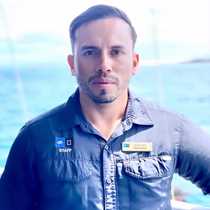Today, we visited the largest town of the Galapagos Islands. We disembarked at the National Park pier and soon headed further into the breeding center to explore the corrals, where the many different projects of National Park are going on.
We first visited the corrals where we saw some dome-shell tortoises that are over a hundred years old. Quite an impressive sight of reptilian titans I would say, these fellows were over a hundred pounds. We also saw Super Diego, a male tortoise from Espanola that had been quite a successful example of conservation efforts in this breeding center, propagating close to 1,800 offspring on the island of Espanola, saving his species from extinction on that island. This is one of the most successful projects in Galapagos. With the efforts of the Galapagos National Park Service, we are able to restore the dynasty of these giants.
After the breeding center, we rode buses to the highlands, where we explored a local hacienda to learn about the processing of sugar cane juice into sugar and alcohol. We also learned about what it takes to process coffee before it gets to our table.
After lunch, we headed in search of the Galapagos giant tortoises in the wild, and were lucky to encounter many of them. Some were eating grass and others were in the rain water ponds, refreshing and cooling off. Several males over 600 pounds were seen actively grazing the grass that had been planted here for the cattle. As more and more tortoises were appearing, we entered a lava tube that was formed by two lava flows, creating a double decker roof, a very interesting geological feature.
We finally returned to the National Geographic Islander to be delighted by a visit from the CEO of the Charles Darwin Foundation to inform us about all of the current projects they were working on. We also enjoyed local musicians performing for us.







